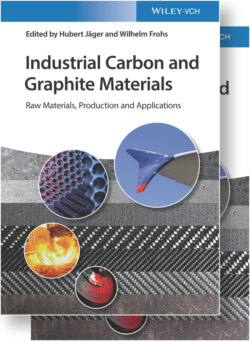Читать книгу Industrial Carbon and Graphite Materials - Группа авторов - Страница 310
6.1.3.4.2 Aggregate for Graphite Electrode in Electric Arc Furnace Steelmaking
ОглавлениеSince the synthetic graphite electrode in electric arc furnace steelmaking is used at high temperature, needle coke in which the crystal structure of aggregate coke is highly ordered is used. Coal tar is a mixture of polycyclic aromatic hydrocarbons, and carbonization of coal tar is anticipated to yield a hard carbon material with the highly crystalline structure. However, in coal tar there is a QI fraction, an amorphous hydrocarbon, which prevents the growth of crystals [6]. Development of the industrial process for elimination of QI first allows the production of pitch needle coke that can be used as the aggregate of the graphite electrode in electric arc furnace steelmaking (refer to Sections 1 and 3.1.2), thereby creating application of the carboniferous material.
The synthetic graphite electrode for steelmaking is produced by kneading needle coke as the aggregate with a binder pitch followed by molding, baking for carbonization of the binder pitch, impregnation of the pitch for adjustment of density, secondary baking, and graphitization. The synthetic graphite electrode for steelmaking is used in an electric arc furnace, which discharges arcs to melt steel scraps. The synthetic graphite electrode is used under severe condition, and the temperature at the electrode tip exceeds 3000 °C when used. Therefore, importance in quality of needle coke as a main raw material, particularly the low CTE, is emphasized. Pitch needle coke has the well‐developed crystal structure as compared with petroleum needle coke and has the properties in which the CTE of products obtained after graphitization is low.
The Acheson furnace has been used in the graphitization process in which heat treatment exceeding the temperature of 2000 °C is performed to produce the synthetic graphite electrode for steelmaking. The Acheson furnace has been developed in the 1990s and is widely used at present as the graphitization equipment. Adoption of the lengthwise graphitization (LWG) furnace in which the electric current is directly applied to energize a semifinished product (baked product) for graphitization in a short time has been initiated in the 1960s, and at present the LWG furnace stays as mainstream equipment in adoption for the graphitization process of the synthetic graphite electrode.
A baked product exhibits irreversible thermal expansion called the puffing in the graphitization process. A method of decreasing the puffing of needle coke is reported by Mochida et al. as follows [8]:
1 1. Reducing the contaminant atoms sulfur and nitrogen in the coke feed or coke.
2 2. Modifying pore distribution in the coke.
3 3. Changing the heating programs used in calcination and graphitization to control the evolution of contaminant gases.
4 4. Trapping the heteroatoms or modifying the time of their evolution (accelerating or delaying.
Nippon Steel Chemical Co., Ltd. (at present, Nippon Steel & Sumikin Chemical Co., Ltd.) has developed in the 2000s pitch needle coke with reduced puffing, and it is widely used.
In China where production of PC is grown, a similar process to remove the QI fraction is developed, and the production of the aggregate for the synthetic graphite electrode in electric arc furnace steelmaking is grown. An annual production volume of PC including needle PC with the grade lower than the regular grade is estimated to be approximately 500 000 t.
Typical properties of PC used as the aggregate in various applications are given in Table 6.1.3.6.
